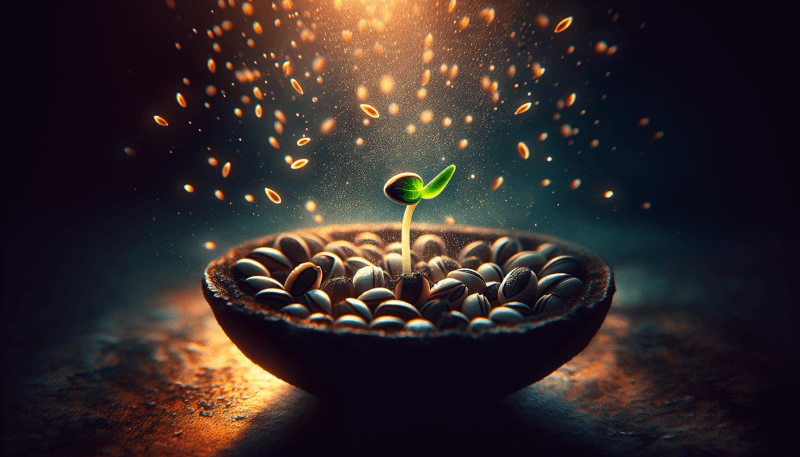👋 Click the mic button to talk to Alfred, the Todd's Seeds Gardening/Sprouting Expert – Feel free to ask him anything!
Ask Virtual Todd Anything - Click the Mic
Are you interested in gardening and looking for some inspiration to start your own little green haven? Look no further! This article provides a glimpse into different sprouting seeds examples that you can easily grow at home. With a variety of options ranging from sunflower and broccoli sprouts to lentils and mung beans, you’ll have a selection of nutritious and delicious additions to your meals. Discover the joy of watching these tiny seeds transform into vibrant and flavorful sprouts, adding a fresh touch to your culinary adventures.

Vegetable Seeds
Broccoli
Broccoli is a popular vegetable that is not only delicious but also packed with essential nutrients. By growing broccoli from seeds, you can ensure that you have access to fresh, homegrown broccoli throughout the year. Broccoli seeds can be sown directly in your garden or started indoors and then transplanted outside. They require well-drained soil and should be planted in a sunny location. With proper care and regular watering, you can enjoy a bountiful harvest of crisp and flavorful broccoli.
Radish
Radishes are a versatile vegetable that can be grown from seeds with ease. They are known for their fast growth and can be a great option for beginner gardeners. Radish seeds can be sown directly in the garden as they prefer cool weather and tolerate mild frost. They require well-draining soil and regular watering for optimal growth. Within a few weeks, you can harvest crunchy, spicy radishes that can be enjoyed in salads, pickles, or even as a garnish for various dishes.
Alfalfa
Alfalfa seeds are not only nutritious but also excellent for sprouting. They are rich in vitamins, minerals, and antioxidants, making them a valuable addition to your diet. To grow alfalfa sprouts, simply soak the seeds overnight and then place them in a sprouting jar or tray. Rinse the seeds thoroughly twice a day until you see tiny leaves forming. In about a week, you will have fresh and crisp alfalfa sprouts ready to be enjoyed in salads, sandwiches, or as a topping for various dishes.
Clover
Clover seeds are commonly used for sprouting and are known for their mild, slightly sweet flavor. They are easy to grow and require minimal care, making them a great option for beginners. To sprout clover seeds, soak them overnight and then place them in a sprouting jar or tray. Rinse the seeds twice a day until you see small leaves emerging. Within a week, you will have fresh and tender clover sprouts that can be used in salads, wraps, or as a nutritious addition to smoothies.
Beetroot
Beetroot seeds can be transformed into vibrant, nutrient-rich plants that produce not only delicious roots but also edible greens. To grow beetroot from seeds, sow them directly in well-drained soil and keep the soil moist but not waterlogged. Beetroot plants prefer cool weather and can be harvested in around 8-10 weeks, depending on the variety. Once harvested, the roots can be roasted, boiled, or pickled, while the greens can be sautéed or used in salads for a burst of color and flavor.

Herb Seeds
Basil
Basil is a versatile and aromatic herb that is easy to grow from seeds. It thrives in warm weather and requires well-drained soil and plenty of sunlight. Basil seeds can be sown directly in the garden or started indoors and then transplanted outside. Regular harvesting promotes bushier growth, so make sure to pinch off the leaves frequently. Fresh basil leaves can be used in a variety of dishes, including pasta, pizza, salads, and even cocktails, adding a delightful freshness to your culinary creations.
Cilantro
Cilantro, also known as coriander, is a herb with distinctive flavor and a wide range of culinary uses. Growing cilantro from seeds is straightforward and rewarding. Sow the seeds directly in well-drained soil and keep the soil consistently moist. Cilantro prefers cool weather, so it’s best to plant it in spring or early fall. As the plants mature, you can harvest the leaves for fresh cilantro or allow them to go to seed to collect coriander seeds, which can be used as a spice in various cuisines.
Dill
Dill is an herb with a unique taste that enhances the flavor of various dishes. It can be easily grown from seeds and is a popular addition to herb gardens. Dill seeds can be sown directly in well-drained soil and require regular watering and full sun. As the plants grow, their leaves and seeds can be harvested. Fresh dill leaves are commonly used in soups, salads, and fish dishes, while the seeds are used as a spice in pickling and baking, adding a distinct aroma and taste.
Parsley
Parsley is a versatile herb that adds freshness and flavor to a wide range of recipes. Growing parsley from seeds allows you to have a constant supply of this aromatic herb at your fingertips. Parsley seeds can be sown directly in well-drained soil or started indoors and then transplanted. They require moist soil and partial sun to thrive. Once the plants are mature, you can harvest the leaves for adding to salads, soups, sauces, or use them as a garnish to enhance the visual appeal of your dishes.
Chives
Chives are a popular herb that belongs to the onion family. They are easy to grow from seeds and can be a great addition to any herb garden. Chive seeds can be sown directly in well-drained soil or started indoors, ensuring a steady supply of this flavorful herb throughout the year. Chives prefer full sun or partial shade and regular watering. As they mature, you can harvest the long, slender leaves and use them as a garnish or as a tasty addition to salads, dips, and various savory dishes.

Grain Seeds
Wheat
Wheat is a staple grain that can be grown from seeds, providing you with a rewarding and sustainable source of this versatile food. Wheat seeds can be sown directly in your garden or in containers. They require full sun and well-drained soil for optimal growth. Regular watering is essential, especially during dry periods. As the wheat plants mature, you can harvest the grains and use them for baking bread, making pasta, or grinding them into flour for various culinary creations.
Barley
Barley is a versatile grain that can be grown from seeds and used in a variety of culinary applications. It is known for its nutritional benefits and can even be used to brew beer. Barley seeds can be sown directly in well-drained soil and require full sun or partial shade. Regular watering is necessary, especially during dry spells. Once the plants mature, you can harvest the grain and use it for making soups, stews, salads, or grind it into flour for baking bread or pastries.
Oats
Oats are a nutritious and widely enjoyed grain that can be grown from seeds in your garden. They are known for their resilience and ability to tolerate various soil types. Oat seeds can be sown directly in well-drained soil and require full sun or partial shade. Regular watering is necessary for optimal growth. As the oat plants mature, you can harvest the grains and use them for making porridge, granola, cookies, or even grind them into flour for baking purposes.
Quinoa
Quinoa has gained popularity in recent years due to its nutritional value and versatility in cooking. This ancient grain can be grown from seeds and is a great addition to any garden. Quinoa seeds can be directly sown in well-drained soil and require full sun and regular watering. As the plants grow, they will produce clusters of seeds. Harvest the quinoa when the seed heads have turned from green to yellow or red. The harvested seeds can be rinsed and then cooked, becoming a delicious and protein-packed ingredient for salads, side dishes, or even as a substitute for rice.
Rice
Rice is a staple food for many cultures and can also be grown from seeds in your own backyard. While rice is commonly grown in flooded fields, you can also grow it in containers or raised beds with a consistent water supply. Rice seeds should be started by soaking them in water for a day or two before planting them in soil that is continuously moist. Keep the rice plants in a sunny location and ensure they receive enough water, especially during the growing season. Harvesting rice involves cutting the stalks when they turn golden brown and allowing them to dry before separating the grains.

Legume Seeds
Lentils
Lentils are a nutritious and versatile legume that can be grown from seeds in your garden. They are a great source of protein, fiber, and various essential nutrients. Lentil seeds can be directly sown in well-drained soil and require full sun. They do not tolerate waterlogged soil, so ensure proper drainage. Lentils are cool-season crops and should be planted in spring or fall. As the plants mature, the lentil pods will dry, and you can harvest the seeds. These can be used in a multitude of dishes, including soups, stews, curries, and salads.
Mung Beans
Mung beans are a popular legume that can be sprouted from seeds and used in a variety of dishes. They are rich in protein, fiber, and antioxidants, making them a nutritious addition to your diet. To sprout mung beans, soak the seeds overnight and then place them in a sprouting jar or tray. Rinse the seeds twice a day until you see small sprouts emerging. Within a few days, you will have fresh and crunchy mung bean sprouts that can be used in stir-fries, salads, wraps, or even as a topping for sandwiches.
Chickpeas
Chickpeas, also known as garbanzo beans, are a versatile legume that can be grown from seeds and used in a variety of recipes. They are rich in protein, fiber, and other essential nutrients. Chickpea seeds can be directly sown in well-drained soil and prefer full sun. Regular watering is necessary for optimal growth. As the plants mature, they will produce distinctive round pods containing the chickpeas. Harvest the chickpeas when the pods have dried and the beans have hardened. They can be used in a variety of dishes, including hummus, curries, stews, salads, or even roasted as a healthy snack.
Peas
Peas are a delicious and classic vegetable that can be grown from seeds with relative ease. They are known for their sweet flavor and nutritional value. Pea seeds can be directly sown in well-drained soil and require full sun or partial shade. Regular watering is essential, especially during dry spells. As the pea plants grow, you can harvest the tender pea pods, which can be enjoyed fresh, cooked, or even frozen for later use. Peas are an excellent addition to salads, stir-fries, soups, or can even be enjoyed on their own as a healthy snack.
Soybeans
Soybeans, also known as edamame, are a nutrient-dense legume that can be grown from seeds and harvested for their delicious and versatile beans. Soybean seeds can be directly sown in well-drained soil and require full sun. Regular watering is necessary for optimal growth. As the plants mature, they will produce pods filled with green soybeans. Harvest the pods before they turn fully yellow or brown, as this is when the beans are at their peak tenderness. Soybeans can be used in a variety of recipes, such as stir-fries, soups, salads, or even enjoyed on their own as a healthy snack.

Flower Seeds
Sunflower
Sunflowers are not only beautiful but also incredibly easy to grow from seeds. They are known for their large, vibrant flowers and nutritional value. Sunflower seeds can be sown directly in well-drained soil and require full sun. Regular watering is necessary for optimal growth. As the sunflower plants mature, they will produce stunning flowers that follow the sun’s direction throughout the day. Once the flowers have wilted, you can harvest the sunflower seeds and enjoy them as a tasty and nutritious snack, or even use them in baking or as a topping for salads and desserts.
Mung Bean
Mung beans, apart from being a nutritious legume, can also be grown as sprouts for ornamental purposes. By sprouting mung bean seeds, you can enjoy the natural beauty of the bean sprouts in your garden or home. Simply soak the seeds overnight and then place them in a sprouting jar or tray. Rinse the seeds twice a day, and within a few days, you will have lush and green mung bean sprouts ready to be showcased as a decorative element in your living space or used as a unique and nutritious garnish for salads, sandwiches, or other dishes.
Alfalfa
Alfalfa, known for its vibrant green leaves and delicate flowers, can be grown from seeds to add a touch of beauty to your garden. Alfalfa seeds can be directly sown in well-drained soil and require full sun. Regular watering is essential for optimal growth. As the alfalfa plants mature, they will develop lush foliage and charming purple flowers. You can enjoy the aesthetic appeal of the alfalfa plants in your garden or even harvest young leaves for salads, wraps, or use them as a nutritious addition to smoothies.
Clover
Clover is a small, delicate flower that can create a charming and colorful display in your garden. Clover seeds can be sown directly in well-drained soil and require full sun or partial shade. Regular watering is necessary for optimal growth. As the clover plants mature, they will produce clusters of flowers in various shades of pink, white, or purple, depending on the clover variety. Enjoy the beauty of the blooming clover in your garden and appreciate the contribution of these flowers in attracting beneficial insects and pollinators.
Broccoli
Although known primarily as a vegetable, broccoli plants can also produce beautiful, edible flowers. Broccoli seeds can be grown into plants that develop large, vibrant flower heads, perfect for adding a touch of color to your garden or as a delightful addition to your plate. Broccoli seeds can be directly sown in well-drained soil and prefer full sun. Regular watering is necessary for optimal growth. As the plants mature, you can enjoy the stunning flower heads before they fully open, appreciating the beauty and uniqueness of broccoli in both its conventional and floral forms.
In conclusion, growing plants from seeds can be a rewarding and enjoyable experience. Whether you are interested in cultivating vegetables, herbs, grains, legumes, or flowers, there are plenty of options to explore. By following the proper planting techniques, providing adequate care, and embracing the wonders of nature, you can witness the transformation of tiny seeds into thriving plants that provide a bountiful harvest or simply add beauty to your surroundings. So, grab your favorite seeds and embark on a gardening journey that is sure to bring joy and satisfaction to your green thumbs!